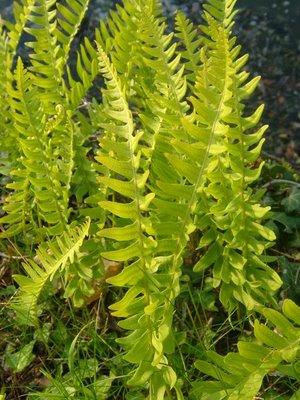Facts And Pictures Of Polypody

Description
Rhizome: creeping, branching, whitish waxy, rather thick, with phylopodia, scales lanceolate, base and margins light brown, sometimes with dark central stripe.
Frond: 25 cm high by 7 cm wide, evergreen, new fronds early summer, monomorphic, blade/stipe ratio: 1:1 to 3:1.
Stipe: jointed at base, straw-colored, narrowly triangular, red-brown scales, to 4 mm, these scales are peltate, vascular bundles: 3 at the base, unifying upwards into an open v-shape.
Blade: pinnatifid, lanceolate to linear, parallel sides in the lower half, truncated base, leathery or herbaceous, mid green, dull in shade, rachis sparsely scaly below, glabrous above; scales lanceolate-ovate.
Pinnae: 10 to 20 pair, alternate; margins entire or crenate, rarely serrate; veins free, forking.
Sori: round, discrete, sunken into the lamina, bulging on the top surface, midway between margin and midrib, on the upper half of the blade, indusium: absent, sporangia: early green, later yellow, then rusty brown, maturity: late summer to early fall.
Dimensionality: normally the lowest pinnae pair only slightly bending forward, down; pinnae rolling up into the rachis, above the plane, when desicated or in winter.

Culture
Habitat: acidic, well-drained locations, on rocks, logs, hillsides.
Distribution: central and northern Europe, less common southern Europe, occurence elsewhere often segrated into other taxa. Hardy to -25°C, USDA Zone 5.

Polypody - delicate perennial fern growing to a height of 1 ft (30 cm). Polypody has slender knotty rhizomes and curving fronds that are dotted with brown spores (sori) on their lower surface.
Polypody rhizome contains saponins (based on polypodosapogenin), ecdysteroids, phloroglucins, volatile oil, fixed oil, and tannins.

Native to Europe and northern Asia, polypody is commonly found growing in damp woodland and thickets, and on walls. The rhizome is unearthed in autumn.

Polypody stimulates bile secretion and is a gentle laxative. Traditionally, polypody has been used in European herbal medicine as a treatment for hepatitis and jaundice, and as a remedy for indigestion and loss of appetite. Polypody makes a safe treatment for constipation in children. The rhizome is also expectorant, having a supportive and mildly stimulating effect on the respiratory system. It may be taken for the relief of congestion, bronchitis, pleuisy, and dry irritable coughs. The rhizome combines well with marsh mallow.







0 Comments:
Post a Comment
<< Home